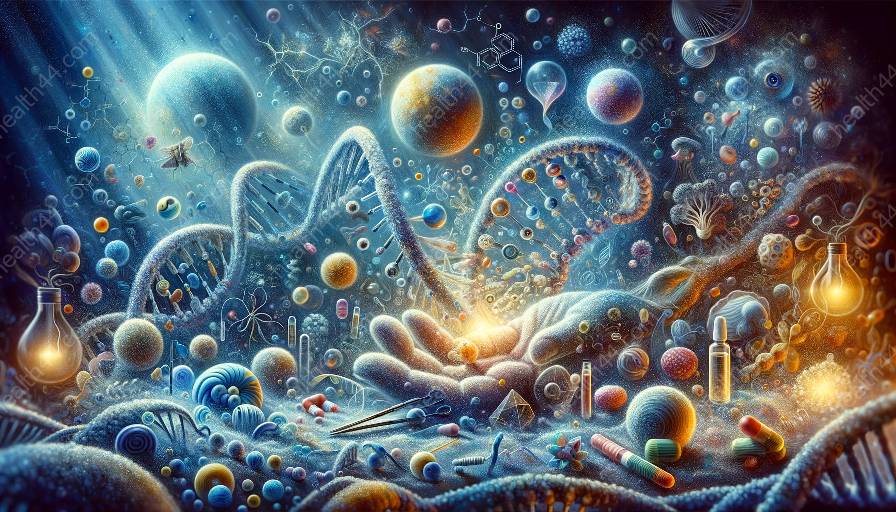Genetics forms the foundation of inheritance and hereditary traits, outlining the blueprint for the complex machinery of life. However, genetics alone cannot account for the intricate dance of genes that orchestrates the functioning of living organisms. This is where epigenetics steps into the spotlight, shaping the expression and regulation of genes in a manner that extends beyond the DNA sequence itself.
Understanding Basic Genetics
Before delving into the role of epigenetics, it's crucial to establish a foundational understanding of basic genetics. Genetics focuses on the study of genes, genetic variation, and heredity in living organisms. Fundamentally, genetic information is stored in the form of DNA, which consists of a sequence of nucleotide bases, namely adenine (A), thymine (T), cytosine (C), and guanine (G).
The specific sequence of these nucleotide bases encodes the instructions for various biological processes, including the synthesis of proteins, which are the molecular workhorses behind most cellular functions. Genes, which are segments of DNA, serve as the blueprints for the production of specific proteins or functional RNA molecules.
The Role of Epigenetics
Epigenetics, on the other hand, delves deeper into the realm of gene expression and regulation, offering insights into how external and environmental factors can influence the activity of genes without altering the underlying DNA sequence. The term 'epigenetics' itself, derived from the Greek word 'epi,' meaning 'above' or 'in addition to,' emphasizes the aspect of control that operates over and above the genetic code.
At its core, epigenetics involves changes in gene activity that do not involve alterations to the DNA sequence itself. These changes can influence how genes are expressed, turning them on or off based on the demands of the environment or developmental stage of an organism. In a sense, epigenetic modifications act as a layer of instructions that control when, where, and to what extent specific genes are expressed, effectively orchestrating the symphony of cellular functions.
Epigenetic Mechanisms
Several mechanisms contribute to the orchestration of epigenetic modifications, with each playing a unique role in regulating gene expression. The main epigenetic mechanisms include DNA methylation, histone modification, and RNA-based mechanisms such as microRNAs and long non-coding RNAs.
DNA Methylation: This process involves the addition of a methyl group to the DNA molecule, typically at specific cytosine bases within the DNA sequence. DNA methylation plays a critical role in gene regulation, as it can inhibit gene expression by impeding the binding of transcription factors or other proteins to the DNA.
Histone Modification: Histones are the proteins around which DNA is wound to form chromatin, the complex structure that packages DNA within the nucleus. Histone modification involves the addition or removal of chemical groups to the histone proteins, influencing the accessibility of the DNA and thereby regulating gene expression.
RNA-Based Mechanisms: MicroRNAs and long non-coding RNAs (lncRNAs) are involved in post-transcriptional gene regulation, affecting the stability or translation of specific messenger RNAs (mRNAs). These small RNA molecules can fine-tune gene expression by targeting and modulating the activity of specific mRNAs.
The Inheritance of Epigenetic Changes
One of the most intriguing aspects of epigenetics is its role in inheritance and the transmission of epigenetic modifications across generations. While genetic information is predominantly transmitted through the DNA sequence itself, epigenetic changes can also be inherited, albeit in a more dynamic and intricately regulated manner.
Transgenerational epigenetic inheritance refers to the transmission of epigenetic modifications from one generation to the next, independent of changes in the DNA sequence. This phenomenon challenges the prevailing notion that only genetic information, encoded in the DNA, dictates the hereditary traits of organisms. Instead, epigenetic inheritance highlights the potential for environmental cues and experiences to leave a lasting imprint on the epigenome of an organism, influencing the traits of subsequent generations.
Epigenetic Influences on Development and Disease
Unraveling the complexities of epigenetic regulation and its impact on gene expression has far-reaching implications in understanding various aspects of development and disease. Epigenetic modifications play a pivotal role in shaping the developmental processes of organisms, orchestrating the precise activation and silencing of genes that drive cellular differentiation and tissue specialization.
Conversely, dysregulation of epigenetic mechanisms has been implicated in a myriad of human diseases, ranging from cancer and neurological disorders to metabolic conditions. Aberrant epigenetic modifications can lead to the misexpression of genes, disrupting the delicate balance of cellular functions and contributing to disease pathogenesis.
Integration of Epigenetics with Modern Genetics
As our understanding of epigenetics continues to evolve, efforts are underway to integrate epigenetic insights with traditional genetic frameworks. The interdisciplinary nature of genetics and epigenetics has fueled collaborative endeavors aimed at deciphering the crossroads between genetic and epigenetic regulation.
Emerging technologies, such as epigenome mapping and single-cell epigenomics, provide unprecedented opportunities to unravel the intricate landscapes of epigenetic modifications across diverse cell types and developmental stages, offering a panoramic view of gene regulation at the epigenetic level.
Conclusion
In summary, the role of epigenetics in gene regulation extends beyond the linear sequence of genetic information, enriching our understanding of how genes are orchestrated and modulated in response to environmental cues and developmental signals. Epigenetic mechanisms introduce a layer of complexity and versatility in gene expression, contributing to the dynamic interplay of genetic and epigenetic regulation that underpins the marvels of life.


